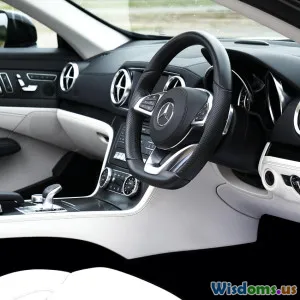
Innovative Features in Modern Cars
8 min read Explore groundbreaking innovations reshaping modern cars, from AI assistance to sustainable tech and enhanced safety. (0 Reviews)
Innovative Features in Modern Cars: Pioneering the Future of Driving
Introduction
The automotive industry is undergoing one of the most transformative revolutions in its history. Modern cars are no longer just mechanical machines designed to get us from point A to B but sophisticated mobile technology hubs brimming with innovations. These pioneering features not only drastically improve safety and efficiency but also elevate comfort, connectivity, and environmental responsibility. Have you ever wondered how vehicles today can park themselves, communicate with other cars, or even learn your driving preferences? This article dives into the groundbreaking innovations defining the future of automobiles, highlighting technologies reshaping the way we drive, perceive cars, and interact on the road.
Artificial Intelligence and Enhanced Safety Systems
AI-Powered Driver Assistance
Artificial Intelligence (AI) has become a cornerstone of modern automotive safety. Systems like Tesla’s Autopilot, General Motor’s Super Cruise, and BMW’s Driving Assistant Professional utilize AI to process data from numerous sensors — including cameras, radar, and LIDAR — to offer adaptive cruise control, lane-centering, and collision avoidance.
- Example: Tesla's Full Self-Driving (FSD) Beta employs neural networks to interpret real-time data and make instant driving decisions, advancing from basic driver aids to near-autonomous capabilities.
AI-driven emergency braking systems can detect pedestrians, cyclists, and sudden obstacles with surprising accuracy, mitigating accidents before the driver reacts. According to a 2021 IIHS study, vehicles equipped with automated emergency braking systems saw a 50% reduction in front-to-rear crashes.
Real-World Impact
Ford’s Co-Pilot360 technology package integrates AI and sensor fusion, offering blind-spot detection, lane-keep assist, and pre-collision assist on a broad range of vehicles. These systems act as a “second pair of eyes” that increasingly outperform human reaction times, saving thousands of lives annually.
Sustainable and Green Technologies
Electric and Hybrid Powertrains
The shift towards sustainability is palpable in the rise of electric vehicles (EVs) and hybrids. Companies like Tesla, Volkswagen, and Nissan have pushed the envelope, improving battery longevity and reducing charging times.
-
Battery Innovation: Solid-state batteries, which promise higher energy density and safety compared to traditional lithium-ion batteries, remain in development but could revolutionize the range and charging speed.
-
Example: The Hyundai Ioniq 5 features ultra-fast 800V charging that replenishes battery life from 10% to 80% in just 18 minutes, demonstrating how fast charging is addressing consumer range anxiety.
Use of Sustainable Materials
Modern cars are also integrating eco-friendly materials. BMW’s i3 model famously uses recycled carbon fiber and renewable resources such as eucalyptus wood and natural fibers in its interiors, reducing carbon footprint without compromising quality or luxury.
Advanced Infotainment and Connectivity
Integrating Smartphones and Increased Connectivity
Vehicles today function like smart devices on wheels. Apple CarPlay, Android Auto, and proprietary systems like Tesla’s infotainment interface offer seamless smartphone integration for navigation, music, and communication.
- Voice Recognition: Systems have evolved with natural language processing allowing drivers to control functions intuitively. For instance, Mercedes-Benz’s MBUX (Mercedes-Benz User Experience) utilizes AI to understand varied accents and conversational commands.
Vehicle-to-Everything (V2X) Communication
V2X technology enables cars to communicate with each other, infrastructure, and even pedestrians' smartphones. This networked information exchange allows better traffic management and alerts drivers of hazards before they’re visible.
- Real-Life Insight: Cities like Ann Arbor, Michigan, are piloting V2X-enabled connected vehicles that can warn about red light violations or emergency vehicles approaching, enhancing urban safety.
Autonomous Driving and Beyond
Levels of Autonomy
The journey towards fully self-driving cars is progressing through defined levels set by the SAE International:
- Level 2: Partial Automation (Tesla Autopilot, GM Super Cruise)
- Level 3: Conditional Automation (Audi A8 traffic jam pilot)
- Level 4: High Automation (Waymo driverless taxis in limited zones)
- Level 5: Full Automation (not yet commercially deployed)
Real-World Deployments
Waymo’s autonomous taxis in Phoenix, Arizona, provide an illuminating glimpse into the autonomous future. With over 20 million miles driven autonomously, these vehicles demonstrate safety improvements and operational viability.
Ethical & Regulatory Challenges
Fully autonomous cars face significant ethical, legal, and infrastructural challenges. Questions about liability in crashes or decision-making in unavoidable accidents remain under debate. However, the technology's capacity to reduce human-error accidents—which account for approximately 94% of all crashes worldwide according to the NHTSA—promises a safer tomorrow.
Enhanced Comfort and Personalization
Adaptive Interiors
Luxury automakers like Mercedes-Benz and BMW are championing interiors with adaptive ambient lighting, ventilated and heated seats, and AI-supported personal settings that adjust music, climate, and seat positions based on learned driver preferences.
Augmented Reality (AR) Displays
Heads-up displays (HUDs) have evolved to include AR overlays translating real-time data, like navigation arrows on the windshield aligned with the road, helping drivers make safer, intuitive decisions without diverting attention.
Volkswagen’s ID.4 and Audi’s e-tron utilize AR HUD technology, marking a step forward in integrating digital information with physical reality.
Conclusion
Modern cars today seamlessly blend cutting-edge technology with everyday practicality, heralding a new era that prioritizes safety, sustainability, connectivity, and comfort. From AI-powered driver aids that reduce accidents to electric powertrains modeling eco-conscious travel, the innovations today unlock a brighter, smarter, and safer driving experience. As the technology incubates, drivers can look forward to increasingly autonomous, personalized, and green vehicles. Whether you are an enthusiast, commuter, or eco-advocate, understanding these transformative features empowers smarter car choices and inspires anticipation for what lies ahead in the automotive domain.
The road to the future is paved with innovation—one smart feature at a time.
Sources & Further Reading:
Rate the Post
User Reviews
Other posts in Artificial Intelligence
Popular Posts
















